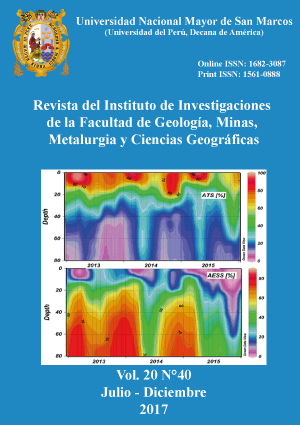Identificación de minerales de alteración hidrotermal aplicando métodos hiperespectrales a imágenes multiespectrales
DOI:
https://doi.org/10.15381/iigeo.v20i40.14386Palabras clave:
Procesamiento de imágenes, cartografía de minerales, teledetección, ASTER, análisis espectral, mapeado de ángulos espectralesResumen
El primer sensor con observación multibanda en la región infrarroja térmica (8-12 micrómetros) con 90 metros de resolución espacial y 5 bandas espectrales especialmente diseñadas para discriminar rocas de la corteza terrestre. Se aplicaron diferentes procedimientos para discriminar minerales de alteración y grupos de roca utilizando no sólo la banda infrarroja térmica sino también las bandas visible e infrarroja cercana.
El área de estudio se encuentra ubicada en el Departamento de Cuzco en la porción sur del Cinturón Volcánico Terciario del Perú y ubicada a 170 kilómetros al noroeste de Arequipa. La zona se encuentra dentro del altiplano peruano a una altitud de 4.470 a 5.370 metros. La disponibilidad de datos multiespectrales a partir del satélite ASTER (radar espacial de reflexión radiométrica) ha proporcionado y aumentado el potencial para la cartografía de los sistemas de alteración hidrotérmica.
El instrumento ASTER tiene seis bandas en la región de Swir estratégicamente posicionada para mapear las características distintivas de absorción de minerales de alteración con enlaces Al-OH y Mg-OH. Eso permite interactuar con el Terra Spec.
Descargas
Publicado
Número
Sección
Licencia
Derechos de autor 2017 Néstor Chacón Abad, Santiago Mayor Pastor

Esta obra está bajo una licencia internacional Creative Commons Atribución-NoComercial-CompartirIgual 4.0.
LOS AUTORES RETIENEN SUS DERECHOS:
a. Los autores retienen sus derechos de marca y patente, y tambien sobre cualquier proceso o procedimiento descrito en el artículo.
b. Los autores retienen el derecho de compartir, copiar, distribuir, ejecutar y comunicar públicamente el articulo publicado en la Rev. Inst. investig. Fac. minas metal cienc. geogr. (por ejemplo, colocarlo en un repositorio institucional o publicarlo en un libro), con un reconocimiento de su publicación inicial en la Rev. Inst. investig. Fac. minas metal cienc. geogr.
c. Los autores retienen el derecho a hacer una posterior publicación de su trabajo, de utilizar el artículo o cualquier parte de aquel (por ejemplo: una compilación de sus trabajos, notas para conferencias, tesis, o para un libro), siempre que indiquen la fuente de publicación (autores del trabajo, revista, volumen, numero y fecha).






